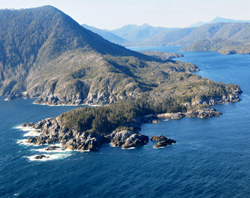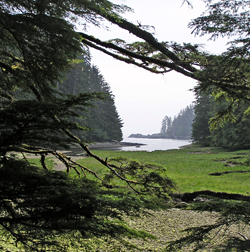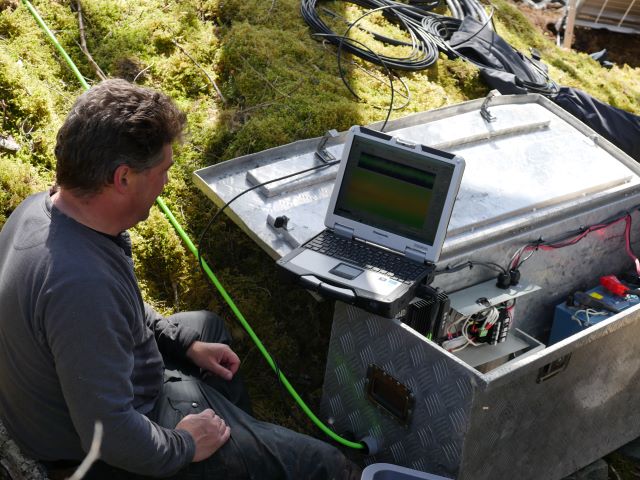Coastal / Marine
Gwaii Haanas National Park Reserve, National Marine Conservation Area Reserve, and Haida Heritage Site
The interconnections between land and sea are most visible on the shorelines, but the sea influences all Gwaii Haanas landscapes in profound ways.
Gwaii Haanas features 1700 km of coastline, which includes biologically diverse ecosystems such as vegetated fringe landward of the shoreline to the shallow sub-tidal (20m depth).
The shores feature rocks of different sizes, sand and estuaries. These ecosystems have received the greatest levels of current and historical human use.

Parks Canada and its partners conduct research and monitoring on a wide range of coastal ecosystems.
Shorebird surveys, including those of keystone species Black Oystercatcher, which serve as sentinel species in detecting early declines in ecosystem health, are conducted regularly. Seabird breeding populations are monitored in key locations.
Invasive fauna (rats, racoons, deer) are monitored throughout Gwaii Haanas with remote cameras. Research and monitoring of coastal physical processes, including surveys of changing dunes and erosion of cultural sites like middens and village sites, is also conducted.

Listening to the Deep
Sound is a way of life for marine species.

The seas are not silent, sound is incredibly important in the marine environment. Whales, dolphins, and porpoises rely on it for navigation, finding mates and food, avoiding predation, and communicating. The waters around Gwaii Haanas are home to many species of marine mammals, ranging from the commonly sighted harbor seals to massive yet seldom seen blue whales.
To better understand who spends time in Gwaii Haanas and when, Gwaii Haanas and Fisheries and Oceans Canada (DFO) began passive acoustic monitoring using hydrophones. Hydrophones are essentially underwater microphones that allow us to listen below the ocean’s surface. Through hydrophone recordings, we can learn a great deal about the marine mammals that spend time in these waters which in turn helps us develop strategies to protect them.
Since 2017, we have focused our efforts on two locations in Gwaii Haanas – one offshore from Gowgaia Bay on the west coast and the other southwest of Ramsay Island in Juan Perez Sound on the east coast. The placement of hydrophones in these locations allows us to target species that come closer to shore in the more protected waters of Juan Perez Sound, as well as open-ocean species along the continental shelf off the west coast.
We also can hear differences in vessel traffic noise between years. For example, we could detect the relative quiet in 2020 and 2021 during the Covid-19 pandemic compared to average noise conditions in the years before 2020. The decline in vessel traffic in 2020 was noticeable on the hydrophone recordings. Twenty-four different cetacean species have been picked up on the hydrophones in Gwaii Haanas since they were first deployed in 2009. Eight of these species are classified as endangered, threatened, or special concern under the Species at Risk Act.
Interested in listening in?
Alaska Resident Killer Whale
Offshore Killer Whale
Humpback Whale
Beaked Whale
Related links
- Date modified :